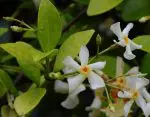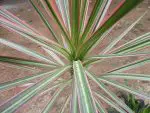This post contains affiliate links. If you buy something from one of our links we may earn a commission. Thanks
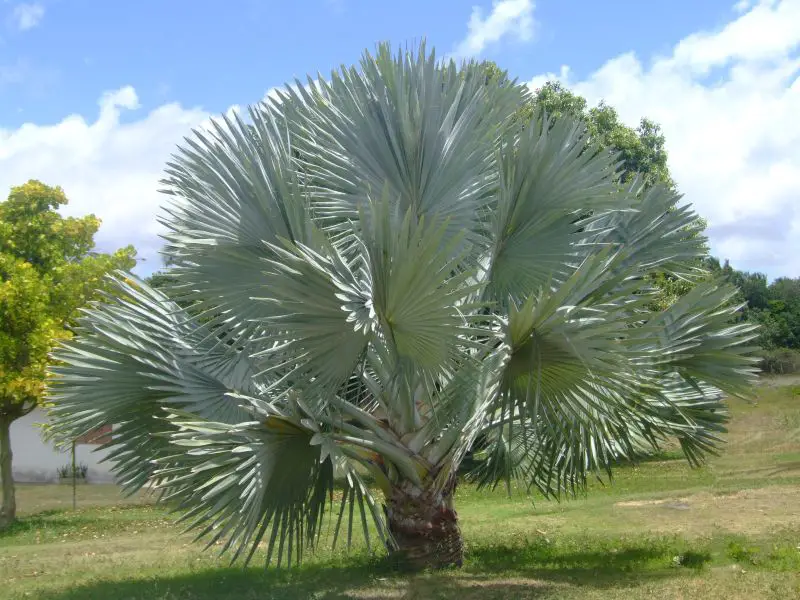
Discover how to care for the Bismarckia Palm indoors and bring a touch of the tropics to your home or office. Learn how to grow this stunning and exotic beauty.
Bismarckia Palm care indoors can be a rewarding endeavor with the right approach. This palm variety appreciates a moderate amount of water and low maintenance, making it suitable for gardeners who prefer less demanding plants.
Hey plant enthusiasts! If you’re on the hunt for an exotic plant to spruce up your indoor space, look no further than the Bismarckia Palm indoors.
This stunning palm tree is also known by its botanical name Bismarckia nobilis or by the common name Bismarck Palm or Silver Bismarck Palm.
Whatever you decide to call these indoor palms with its striking silvery-blue leaves it is sure to add a touch of the tropics to your home or office.
But before you rush out to buy one, there are a few things you should know about caring for this majestic plant.
In this post, we’ll dive into everything you need to know about Bismarckia Palm care indoors, from selecting the right spot to troubleshooting common problems. Let’s get started!
What Is A Bismarck Palm Tree?
The Bismarckia Palm is named after Otto von Bismarck, the first chancellor of Germany.
This majestic palm tree is native to the island of Madagascar and mature specimens can grow up to 60 feet tall in the wild. But indoors in a container, it may reach eight feet.
Its stunning silvery-blue leaves and symmetrical crown have made it a popular choice for landscaping and indoor decor.
While it can take several years for a Bismarck Palm to grow to its full height, its slow growth rate means it can thrive indoors for many years with the right care.
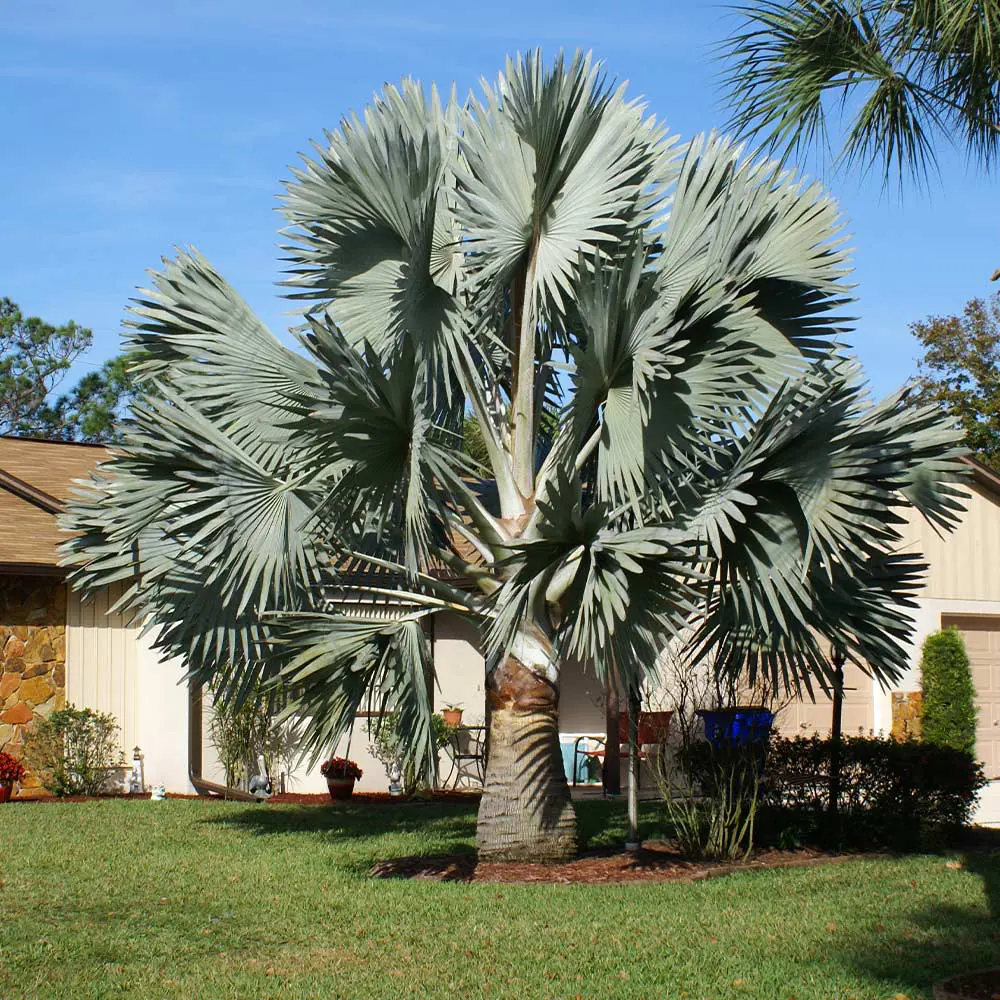
You can buy your own Bismarck Palm Seeds on Amazon
Benefits of having Bismarckia Palm indoors:
The benefits of having a Bismarckia Palm indoors go far beyond its striking appearance.
As a tropical plant, it can help purify the air in your home or office by removing toxins such as benzene, formaldehyde, and carbon monoxide.
Additionally, studies have shown that plants can have a positive impact on mental health and productivity, so having a Bismarck Palm in your indoor space may help you feel more relaxed and focused.
What You’ll Learn In This Blog Post:
The purpose of this blog post is to provide a comprehensive guide to growing and caring for Bismarck Palms indoors.
Whether you’re a seasoned plant enthusiast or a newbie, we’ll cover everything you need to know about selecting the right location, potting, watering, fertilizing, pruning, and troubleshooting common problems.
Our goal is to help you keep your Bismarck Palm happy and healthy so you can enjoy its stunning beauty for years to come.
Characteristics of Bismarckia Palm
The Bismarckia Palm is a truly magnificent plant with a variety of distinctive characteristics that set it apart from other palm trees.
Its striking silvery-blue leaves can span up to 10 feet in diameter, creating a symmetrical crown that’s sure to turn heads.
In the wild, the Bismarck Palm can grow up to 60 feet tall with a stout trunk, although its growth rate is slow enough to keep it manageable for indoor spaces.
The Bismarck Palm is also known for its hardiness and durability, making it a great choice for those who are looking for a low-maintenance yet stunning plant to decorate their home or office.
In this section, we’ll dive deeper into the characteristics of the Bismarck Palm and what makes it such a special addition to any indoor space.
Bismarckia is a monotypic genus of flowering plant in the palm family endemic to western and northern Madagascar where they grow in open grassland. The genus is named for the first chancellor of the German Empire Otto von Bismarck and the epithet for its only species, Bismarckia nobilis, comes from Latin for ‘noble’. https://en.wikipedia.org/wiki/Bismarckia
Appearance:
The Bismarckia Palm is well known for its striking appearance, with its large, symmetrical crown and silvery-blue leaves. It is a stately single trunk palm.
The leaves themselves can span up to 10 feet in diameter, creating an impressive and visually striking focal point in any indoor space.
In addition to its beauty, the Bismarck Palm is also very hardy and can withstand wind and other weather conditions without losing its distinctive shape or color.
Growth rate:
While the Bismarck Palm can grow up to 60 feet tall in the wild, its growth rate is slow enough to make it a manageable indoor plant.
On average, a Bismarck Palm will grow around 2-3 feet per year, depending on the conditions it’s kept in.
While it’s not the fastest-growing plant, its majestic appearance and slow growth rate make it a great choice for those who are looking for a long-lasting, visually stunning addition to their indoor space.
Soil and water requirements:
When it comes to soil type and water requirements, the Bismarck Palm prefers well-drained soil with a slightly acidic pH.
When watering, it’s important to let the soil dry out slightly between waterings to prevent overwatering and root rot.
However, it’s also important to keep the soil consistently moist to prevent the leaves from drying out and losing their distinctive color.
Light and temperature needs:
The Bismarck Palm is a tropical plant that thrives in warm, humid environments. It prefers bright, indirect light but can also tolerate full sun and partial shade.
When it comes to temperature, the Bismarck Palm does best in temperatures between 65-85 degrees Fahrenheit.
Although this palm can handle high temperatures it’s still important to avoid exposing the plant to extreme temperature changes, such as drafts or air conditioning vents, which can cause stress and damage to the leaves.
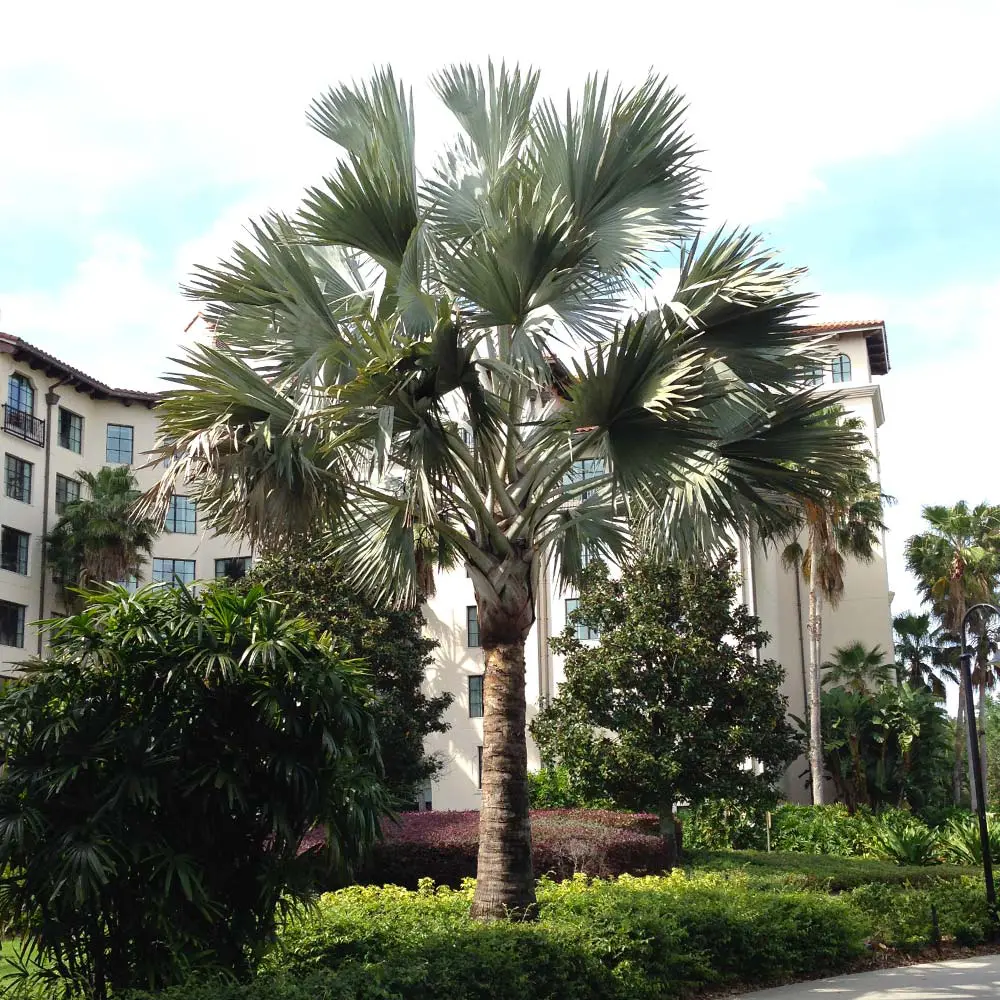
Choosing the right spot for your Bismarckia Palm
Now that we’ve covered the characteristics and care requirements of the Bismarck Palm, it’s time to choose the perfect spot for your new plant.
Choosing the right spot is crucial for the health and growth of your Bismarck Palm, and can also affect its appearance and overall well-being.
In this section, we’ll explore some tips and tricks for finding the ideal location for your Bismarck Palm, taking into account factors such as lighting, temperature, and space requirements.
With the right care and attention, your Bismarck Palm is sure to thrive and become a stunning addition to your indoor space.
Ideal indoor locations:
When it comes to finding the ideal location for your Bismarck Palm, there are a few things to consider.
First, make sure to choose a location that gets bright, indirect light.
Too much direct sunlight may cause the leaves to scorch and fade, while too little light can cause the plant to grow slowly and lose its distinctive color.
In addition, make sure to choose a location that’s away from drafts and air conditioning vents, as these can cause stress and damage to the plant.
Finally, make sure to choose a location with enough space for the Bismarck Palm to grow and spread out its impressive leaves.
Potential challenges:
Like all plants, the Bismarck Palm can face a few challenges when it comes to indoor growth.
One of the most common challenges is overwatering, which can cause root rot and other issues.
In addition, Bismarck Palms can be sensitive to extreme temperature changes, so make sure to avoid placing them near drafty windows or air conditioning vents.
Finally, some indoor spaces may not have enough light or space for the Bismarck Palm to thrive, so it’s important to choose the right location from the start.
Tips for overcoming challenges:
If you’re facing challenges when it comes to growing your Bismarck Palm indoors, there are a few tips and tricks to keep in mind.
First, make sure to water your plant only when the soil is dry to the touch, and avoid letting it sit in standing water.
Second, consider investing in a humidifier to provide the Bismarck Palm with the humid environment it needs to thrive.
Finally, if you’re struggling to find the right location, consider moving the plant around until you find a spot that works best for it.
With a little patience and attention, you can overcome any challenges and help your Bismarck Palm thrive indoors.

Bismarck Palm Outdoors
Unless you live in Southern California or parts of Florida this will not be an outdoor palm. It can only tolerate temperatures down to 30 degrees.
So outdoors the Bismarckia palm’s cold hardiness allows it to be grown in U.S. Department of Agriculture plant hardiness zone 10. Minimum temperatures: Zone 10a 30 to 35 degrees F, Zone 10b 35 to 40 degrees F.
Even though the Bismarck Palm cant tolerate low temperatures they can be outdoor plants during the summer months in other locations in the United States.
The best way is to only give them partial sun at first.
One advantage of coco coir is it is much lighter in weight than regular potting mix so moving a single specimen outdoors is much easier to do.
Just remember to bring your palm back indoors in late fall before cold weather arrives.
Planting and Caring for Bismarckia Palm
Congratulations, you’ve found the perfect spot for your Bismarck Palm! Now it’s time to get your hands dirty and start planting.
In this section, we’ll explore some tips and tricks for planting and caring for your Bismarck Palm, including choosing the right pot, soil, and fertilizer, as well as pruning and pest control.
With the right care and attention, your Bismarck Palm will not only survive, but thrive and become a beautiful addition to your indoor space. Let’s get started!
Soil preparation:
The first step in planting your Bismarck Palm is to prepare the right soil. Bismarck Palms prefer well-draining soil with a slightly acidic pH.
You can create this type of soil by mixing equal parts of peat moss, perlite, and sand.
Make sure to add a layer of gravel or stones to the bottom of the pot to ensure proper drainage. This is a typical soil mix for palms but there are better ones.
Why a coco coir and perlite mix is a better alternative
While peat moss is a popular choice for soil preparation, it’s important to note that it’s a non-renewable resource that’s obtained through the destruction of peat bogs.
As a more sustainable alternative, many gardeners are turning to coco coir, which is made from the fibers of coconut husks.
Not only is coco coir a renewable resource, but it also has excellent water retention properties and provides good aeration to the soil.
When mixed with perlite, which is a volcanic glass material that helps with drainage and aeration, you have a great soil mix that is ideal for Bismarck Palms.
Using a coco coir and perlite mix not only benefits the environment, but it can also lead to healthier and happier Bismarck Palms.
Pot selection:
When it comes to choosing a pot for your Bismarck Palm, it’s important to choose one that’s large enough to accommodate the plant’s root system.
In addition, make sure the pot has drainage holes to prevent water from pooling at the bottom.
Terracotta or ceramic pots are a great choice, as they allow for air circulation and moisture control.
I prefer plastic pots. They are lighter and don’t break.
You can help promote good drainage by removing any runoff from the saucer after you water.
Watering and fertilization:
Bismarck Palms prefer to be kept slightly moist, but not overly wet.
Water your new palm when the top inch of soil feels dry to the touch, and make sure to drain any excess water from the saucer.
In terms of fertilization, use a slow-release fertilizer designed for palm trees, and apply it every three months during the growing season.
A controlled-release granular fertilizer works well and you can incorporate some at planting time or when repotting.
I like to use slow-release fertilizer spikes because they make fertilizing really easy.
The use of tree spikes will take the guesswork out of fertilizing.
Here is what I recommend for  fertilizing your Bismarck Palm.
fertilizing your Bismarck Palm.
I recommend using Jobes Organics fertilizer spikes.
They are easy to use and last for 2-3 months.
They are designed for container-grown citrus but they also work great for palm trees.
Using 2 spikes for a 12-inch pot or 3 for an 18-inch pot takes the guesswork out of fertilizing.
They provide a 3-5-5 fertilizer blend along with micronutrients and beneficial bacteria.
Pruning and maintenance:
Bismarck Palms don’t require much pruning, but it’s important to remove any dead leaves or damaged fronds to keep the plant looking its best.
Cut them off at the old leaf bases being careful not to damage the trunk.
In addition, make sure to wipe the leaves with a damp cloth to remove dust and keep them looking healthy.
Repotting:
As your Bismarck Palm grows, you may need to repot it to accommodate its increasing size.
Repotting should be done every 2-3 years, or when the roots begin to outgrow the pot.
When repotting, make sure to use fresh soil and a pot that’s slightly larger than the previous one.
How to repot a Bismarck Palm
Repotting a Bismarck Palm is an essential part of its care, as it allows the plant to continue growing and flourishing in a healthy environment.
The best time to repot your Bismarck Palm is during the spring or summer months when the plant is actively growing.
To repot your Bismarck Palm, you’ll need a few key supplies, including a larger pot with drainage holes, fresh potting soil, and some gardening gloves.
Here are the steps to follow:
• Choose a new pot that is one or two sizes larger than the current pot.
Make sure the new pot has good drainage holes to prevent water buildup that can cause root rot.
• Prepare the potting soil by using a mix of coco coir and perlite instead of peat moss.
This mix is more sustainable and provides better drainage and aeration to the plant’s roots.
• Water your Bismarck Palm a day or two before repotting to help the roots loosen up from the old soil.
• Put on your gardening gloves and gently remove the Bismarck Palm from its old pot. Be careful not to damage the roots.
• If the roots are tangled or bound, gently loosen them up using your fingers or a garden tool. You can trim off any dead or damaged roots.
• Place a layer of fresh potting soil at the bottom of the new pot, and position the Bismarck Palm in the center.
Make sure the top of the root ball is level with the pot’s rim.
• Fill the pot with fresh potting soil, tamping it down firmly around the plant’s roots.
• Water the plant thoroughly, allowing the water to drain out of the pot’s holes.
• After repotting, keep your Bismarck Palm in a bright, warm, and humid location for a few days to help it recover.
By following these simple steps, you can ensure that your Bismarck Palm has enough space to grow and thrive in a healthy and nurturing environment.
With proper care and attention, your Bismarck Palm will be a stunning addition to your indoor plant collection for years to come.
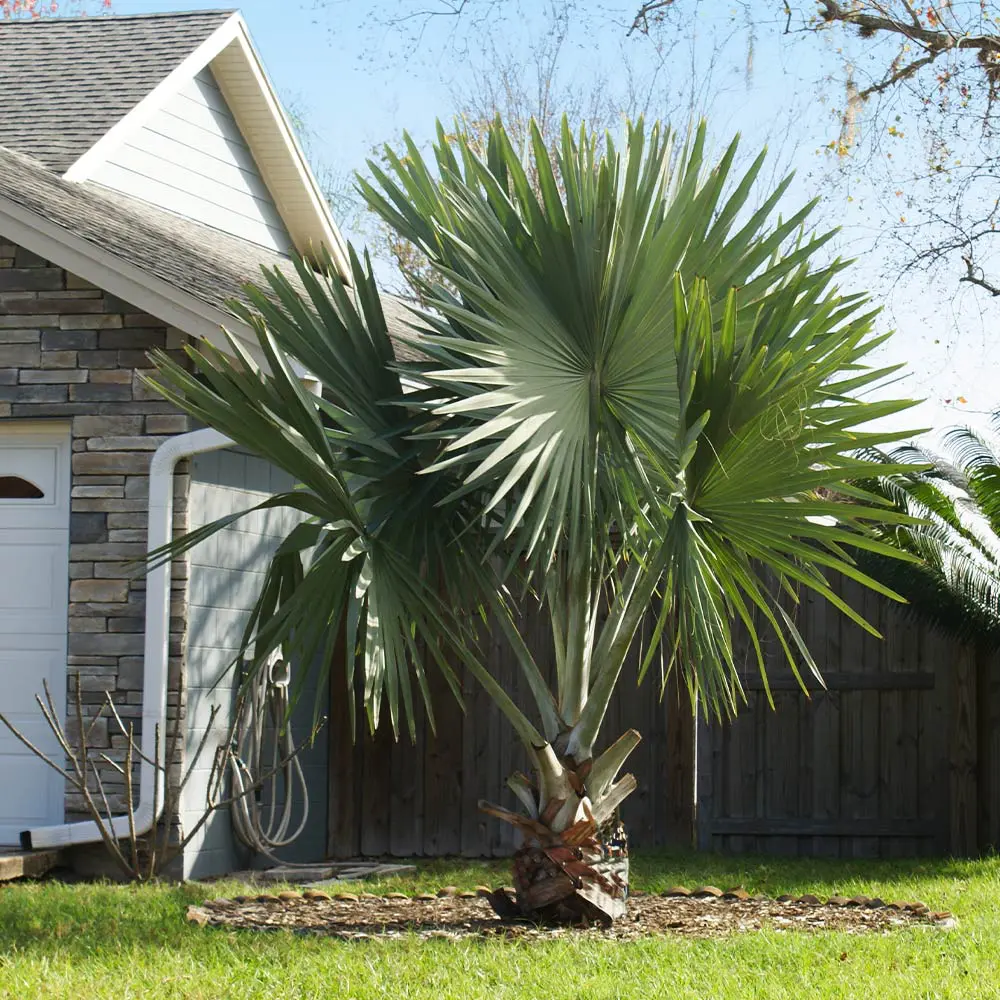
Troubleshooting Common Problems
As with any plant, Bismarck Palms may encounter some issues when grown indoors.
It’s important to keep an eye out for potential problems and address them as soon as possible to keep your palm healthy and thriving.
In this section, we’ll cover some common problems that Bismarck Palm growers may encounter, such as pest infestations, leaf discoloration, and root rot.
We’ll also provide some tips on how to identify these issues and steps you can take to prevent or treat them.
By being proactive and knowledgeable about common problems, you can ensure that your Bismarck Palm remains a beautiful and impressive addition to your indoor space.
Overwatering:
Overwatering is a common problem for Bismarck Palms, and it can lead to root rot and other issues.
Signs of overwatering may include yellowing or wilting leaves, soft or mushy stems, and a musty or sour smell coming from the soil.
To prevent overwatering, make sure your pot has adequate drainage and only water your Bismarck Palm when the top inch of soil feels dry to the touch.
If you suspect that your palm is suffering from overwatering, you may need to repot it into fresh, well-draining soil and cut back on watering.
Underwatering:
While overwatering is a common problem, underwatering can also cause problems for Bismarck Palms.
Signs of underwatering may include dry, brown leaf tips, drooping or wilting leaves, and yellowing leaves.
To prevent underwatering, make sure to water your palm regularly, but don’t overdo it.
As a general rule, water your Bismarck Palm when the top inch of soil feels dry to the touch.
Pest Infestations:
Bismarck Palms are generally resistant to pests, but they can still fall prey to common houseplant pests such as spider mites, mealybugs, and scale insects.
Signs of a pest infestation may include yellow or white spots on the leaves, webbing or cotton-like growths on the plant, or tiny insects on the leaves or stems.
To treat a pest infestation, start by isolating the affected plant and inspecting it closely.
You may be able to remove some of the pests by hand, or you may need to use insecticidal soap or neem oil to treat the plant.
Diseases:
Bismarck Palms are generally hardy plants, but they can be susceptible to diseases such as fungal infections and bacterial leaf spots.
To prevent disease, make sure your palm is getting adequate sunlight and airflow, and avoid overwatering.
If you notice signs of disease, such as brown or yellow spots on the leaves, or black or brown lesions on the stems, you may need to remove the affected parts of the plant and treat it with a fungicide or bactericide.
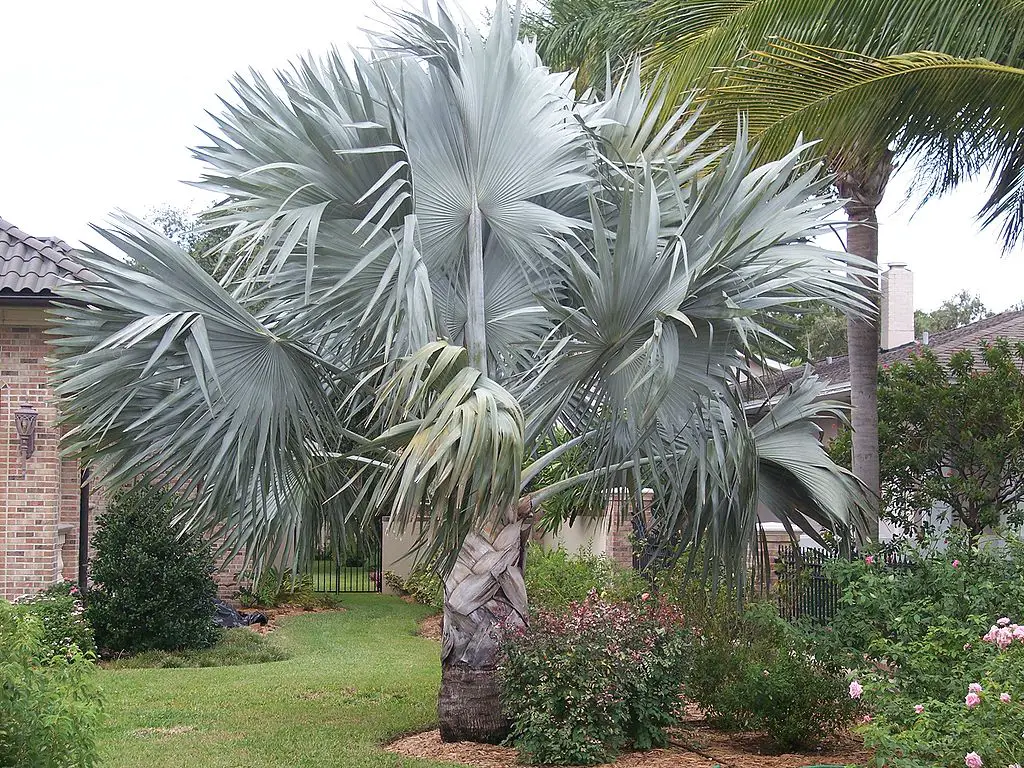
Benefits of Having Bismarckia Palm Indoors
Adding a Bismarck Palm to your indoor plant collection can offer numerous benefits beyond simply adding some greenery to your space.
Not only is the Bismarck Palm a stunningly beautiful plant, but it can also improve indoor air quality, reduce stress levels, and create a relaxing atmosphere.
In this section, we’ll explore some of the specific benefits of having a Bismarck Palm indoors and how it can enhance your living space.
Air purification:
Bismarck Palm is known for its air-purifying qualities. It has the ability to remove toxins such as formaldehyde, benzene, and xylene from the air.
These chemicals can be present in the air due to furniture, paints, carpets, and other household items.
Having a Bismarck Palm in your home can help purify the air and create a healthier living environment.
Aesthetics:
The Bismarck Palm’s stunning blue-green foliage and large fronds make it an eye-catching addition to any indoor space.
Its unique and exotic appearance adds a touch of natural elegance to your home décor.
The Bismarck Palm can grow up to 70 feet tall in its natural habitat, but when grown indoors, it can reach a maximum height of 8-10 feet.
Health benefits:
Research has shown that having plants indoors can provide numerous health benefits, including reduced stress levels and increased productivity.
The Bismarck Palm’s lush foliage can help create a calming and relaxing atmosphere, reducing stress and anxiety.
Additionally, being around plants has been shown to boost mood and cognitive function, leading to increased productivity.
Productivity boost:
In addition to the health benefits, the presence of plants in the workspace has been linked to increased productivity.
Studies have found that employees who have plants in their work environment have improved concentration, memory retention, and overall job satisfaction.
Having a Bismarck Palm in your home office or workspace can help increase productivity and create a more pleasant working environment.
Conclusion For Bismarckia Palm Indoors
In conclusion, the Bismarck Palm is an excellent choice for an indoor plant that offers numerous benefits beyond its beauty.
By following the care guidelines outlined in this blog post, you can grow a healthy and vibrant Bismarck Palm in your home or office.
From its air-purifying qualities to its aesthetic appeal and health benefits, the Bismarck Palm is a plant that can truly enhance your living space.
With a little bit of care and attention, you can enjoy the beauty and benefits of this stunning plant for years to come.
Recap of main points:
To recap, we’ve covered a lot of ground in this blog post about Bismarckia Palm care indoors.
We discussed the brief history of the Bismarck Palm, the benefits of having it indoors, its characteristics, choosing the right spot for it, planting and caring for it, troubleshooting common problems, and the benefits of having it indoors.
We’ve covered everything from its air-purifying qualities and unique aesthetics to its potential challenges and how to overcome them.
Bismarckia Palm FAQs
When it comes to nurturing a Bismarckia Palm indoors, there are several factors to consider to ensure its healthy growth and longevity.
It’s a tropical palm, so mimicking its natural habitat indoors is crucial. Adequate lighting, proper watering, and fertilization are the pillars of indoor care for Bismarckia Palm.
Q. What are the water requirements for Bismarckia Palm indoors?
A. Bismarckia Palms have moderate water requirements. It’s important to keep the soil consistently moist but not waterlogged. Over-watering or letting the palm sit in water can lead to root rot.
Q. How often should I fertilize my indoor Bismarckia Palm?
A. It’s recommended to apply a good quality palm fertilizer with a continuous-release formula twice a year during the growing season. This will help in providing the necessary nutrients for its growth.
Q. What type of light does Bismarckia Palm require indoors?
A. Bismarckia Palm prefers bright, indirect light when grown indoors. It can also tolerate some direct sunlight. However, it’s crucial to avoid extreme sunlight exposure as it can cause leaf burn.
Q. How to manage pests and diseases for Bismarckia Palm indoors?
A. Pests and diseases are rare for Bismarckia Palm, but it’s always good to keep a lookout for common indoor palm pests like spider mites or mealybugs. If you notice any, treat the plant with a gentle insecticidal soap or neem oil.
The indoor care of Bismarckia Palm revolves around replicating its natural tropical habitat as closely as possible.
With proper attention to its light, water, and nutrient requirements, you can enjoy the beauty and benefits of this palm in your indoor space for many years.
Bismarck Palm Care Final thoughts
Overall, the Bismarck Palm is a truly remarkable plant that can enhance your living space in numerous ways.
It is relatively easy to care for and can provide numerous benefits beyond its beauty.
With a little bit of attention and care, the Bismarck Palm can thrive in your home or office and offer you years of enjoyment.
Try Gowing The Bismarck Palm
If you’re considering adding a Bismarck Palm to your indoor plant collection, we encourage you to give it a try.
Follow the care guidelines outlined in this post on Bismarckia palm care and you’ll be well on your way to growing a healthy and vibrant plant.
And, if you already have a Bismarck Palm, we hope this post has provided you with some helpful tips and insights into how to care for it.
Whatever your situation may be, we wish you the best of luck with your Bismarck Palm, and we hope it brings you years of joy and beauty.
You can buy your own Bismarck Palm Seeds on Amazon
Read more: Indoor Palm Tree Care: 11 Powerful Tips Complete Guide For Beginners

